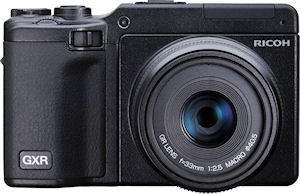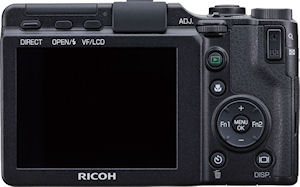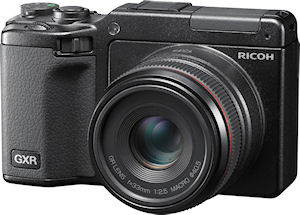 Ricoh digicam with interchangeable lens/sensor modules
Ricoh digicam with interchangeable lens/sensor modules
By
Mike Tomkins
(Tuesday, November 10, 2009 - 16:43 EST)
Japan's Ricoh Co. Ltd. has today announced the Ricoh GXR digital camera, which harks back to Minolta's DiMAGE EX1500 digital camera of eleven years ago, by offering optional modules that allow the lens and sensor to be interchanged together.
The Ricoh GXR camera body itself doesn't contain a lot beyond the LCD display, a flash strobe and hot shoe, microphone and speaker, miscellaneous connectivity, battery and flash slots, plus the various control buttons and dials. The meat of the camera - its lens, sensor and (one presumes) image processor - are to be found in the modules. At launch, two lens/sensor modules will be offered for the Ricoh GXR. One offers a 3x optical zoom range from 24mm to 72mm equivalents with an aperture varying from f/2.5 to f/4.4 across the zoom range, while the other has a fixed focal length equivalent to 50mm, with maximum aperture of f/2.5. The GXR's unusual module-based design is intended to offer several benefits - sensor and lens designs can be tailored to each other, lens complexity and size / weight can be kept down by using a smaller imager as necessary, and sealed modules can potentially keep dust away from the sensor. Potential drawbacks include the cost of bundling a sensor with every lens, tying lens upgrades to sensor upgrades, and increased complexity. While US pricing for the GXR hasn't been officially announced, the camera and both modules have already appeared in the inventory of reputable US retailers. US street pricing for the Ricoh GXR body is a rather steep $550 for the camera body without a module. Street pricing for the 50mm-equivalent lens module with APS-C sensor is $830, and the 24 - 72mm equivalent zoom lens module with 1/1.7" sensor is another $440. That brings the total cost for the system without optional external viewfinder to $1,820, leaving Ricoh with something of a challenge, when two cameras offering not dissimilar combined specifications can be purchased together for several hundred dollars less. For more details, read our Ricoh GXR preview. Several sample images can be seen on Ricoh's website. | Ricoh GXR | 
with optional APS-C sensor / 50mm equiv. lens module | | General | | Camera Type | Other | | Manufacturer | Ricoh | | Model Number | GXR | | Dimensions | With A12 lens module:
4.5 x 2.8 x 3.0 in.
(114 x 70 x 77 mm) With S10 lens module:
4.5 x 2.8 x 1.7 in.
(114 x 70 x 44 mm) | | Weight (body only) | With A12 lens module:
14.9 oz
(423 g) With S10 lens module:
11.5 oz
(325 g) | | Street Price | With A12 lens module:
$1,380 With S10 lens module:
$990 | | Planned Availability | December 2009 | | Image Capture | | Sensor Type | With A12 lens module:
APS-C CMOS (approx. 1.12 in. diagonal)
12.90 megapixels (total)
12.30 megapixels (effective) With S10 lens module:
1/1.7" CCD
10.4 megapixels (total)
10.0 megapixels (effective) | | Aspect Ratio | 1:1, 4:3, 3:2, 16:9 | | Image Dimensions | With A12 lens module:
4288 x 2848 (12.2 megapixels)
3776 x 2832 (10.7 megapixels)
4288 x 2416 (10.4 megapixels)
2848 x 2848 (8.1 megapixels)
3456 x 2304 (8.0 megapixels)
3072 x 2304 (7.1 megapixels)
3456 x 1944 (6.7 megapixels)
2304 x 2304 (5.3 megapixels)
2592 x 1944 (5.0 megapixels)
2048 x 1536 (3.1 megapixels)
1280 x 960 (1.2 megapixels)
640 x 480 (0.3 megapixels) With S10 lens module:
3648 x 2736 (10.0 megapixels)
3648 x 2432(8.9 megapixels)
3264 x 2448 (8.0 megapixels)
3648 x 2048 (7.5 megapixels)
2736 x 2736 (7.5 megapixels)
3648 x 2176 (7.9 megapixels)
3264 x 1840 (6.0 megapixels)
2448 x 2448 (6.0 megapixels)
2592 x 1944 (5.0 megapixels)
2048 x 1536 (3.1 megapixels)
1280 x 960 (1.2 megapixels)
640 x 480 (0.3 megapixels) | | Capture Speed | With A12 lens module:
Continuous: 3.0 frames per second for 15 frames With S10 lens module:
Continuous: 1.6 frames per second for 15 frames | | Image Preview / Review | | Viewfinder | Yes (optional external electronic viewfinder, details unknown) | | LCD | 3.0 in. diagonal
920,000 dots (approx. 307,000 pixels) | | Playback Zoom | 16.0x max | | Lens | | Lens Mount | Ricoh GXR | | Image Stabilization | With A12 lens module:
No With S10 lens module:
Yes (sensor shift-type) | | Focal Length | 33.0 - 50.0mm (actual) | | Aperture Range | With A12 lens module:
f/2.5 - f/22 With S10 lens module:
f/2.5 (wide) / f/4.4 (tele) - ??? | | Focusing System | Contrast detection multi / spot
Does not have AF assist lamp
Manual focus possible | | Focusing Range | With A12 lens module:
Normal: 12" - infinity (30 cm - infinity)
Macro: 2.9" - 4,082" (7 cm - infinity) With S10 lens module:
Normal: 12" - infinity (30 cm - infinity)
Macro: 0.4" - 4,082" (1 cm - infinity) | | Exposure | | ISO Sensitivity | With A12 lens module:
Auto, 200, 400, 800, 1600, 3200 With S10 lens module:
Auto, 100, 200, 400, 800, 1600, 3200 | | Shutter Speed | With A12 lens module:
180 - 1/3200 second With S10 lens module:
180 - 1/2000 second | | Exposure Modes | Program, Aperture, Shutter, Manual | | Metering Modes | TTL by CCD, 256-segment multi, center-weighted or spot | | Exposure Compensation | +/- 4.0EV in 1/3EV increments | | White Balance | Image Sensor - Auto, Multi-P AUTO, Outdoors, Cloudy, Incandescent Lamp, Fluorescent Lamp, Manual Setting | | Internal Flash | Modes: Auto, red-eye, on, slow sync, manual (FULL, 1/1.4, 1/2, 1/2.8, 1/4, 1/5.6, 1/8, 1/11, 1/16, 1/22, 1/32, 1/64), off
With A12 lens module:
Range: 20cm - 3m (ISO AUTO) With S10 lens module:
Range: 20cm - 4.5m (Wide, ISO AUTO); 15cm - 2.7m (Tele, ISO AUTO) | | Flash Exposure Compensation | +/- 2.0EV in 1/3EV increments | | Creative | | Scene Modes | With A12 lens module:
Movie, portrait, sports, landscape, nightscape, skew correction With S10 lens module:
Movie, portrait, sports, landscape, nightscape, skew correction, zoom macro | | Digital Zoom | With A12 lens module:
4x (3.6x for movies) With S10 lens module:
4x | | Self Timer | Yes, 2 or 10 seconds | | Time Lapse | Yes | | Movie Format | AVI (OpenDML Motion JPEG) with audio | | Storage | | Recording Medium | SD/MMC including SDHC, Built-in | | File Format | .DNG Raw, JPEG (EXIF v2.21) | | Connectivity | | Video | High definition: Yes (HDMI)
Standard definition: Yes, NTSC / PAL switchable | | Computer | USB 2.0 High Speed | | Power | | Battery Type | 3.6V Lithium-ion rechargeable | | Battery Form Factor | Proprietary DB-90 | | Product Bundle | | Software | DL-10, Irodio Photo and Video Studio, Adobe Reader, VM-1 for Mac | | Flash Memory | 86.0MB built-in memory | | Other | | Internal Microphone | Yes | | Internal Speaker | Yes | | Tripod Mount | Yes | | Remote Control | No | | Notes | Sensor and lens are interchangeable as one unit. | | More Photos |  | 
with optional APS-C sensor / 50mm equiv. lens module | | |
|
Original Source Press Release:
| Ricoh announces the GXR interchangeable unit camera system Lens, image sensor, and image processing engine integrated into a single interchangeable unit. World's smallest and lightest*. Tokyo, Japan, November 10, 2009—Ricoh Co., Ltd. (president and CEO: Shiro Kondo) today announced the development and release of the GXR interchangeable unit camera system featuring the world's smallest and lightest* digital camera with the ability to change lenses. The new GXR is an interchangeable unit camera system in which lenses are changed by using a slide-in mount system to attach camera units to the body. The lens, image sensor, and image processing engine are integrated into the camera units so the body itself does not contain an image sensor. With world-leading small size and low weight* enabling easy carrying, the GXR interchangeable unit camera system features a highly rigid magnesium alloy body and multiple camera units that can be changed to best fit the scene to be photographed. You can enjoy easy lens changes as well as amazing image quality and shooting flexibility. Concealing infinite possibilities in its small body, the GXR is a revolutionary camera system that pioneers a new realm of photography. Distinctive characteristics Lens, image sensor, and image processing engine comprise an integrated unit which can be changed to match the scene being photographed. World's smallest and lightest* digital camera with interchangeable lenses System potential expanded through use of interchangeable units
*Internal flash, interchangeable lens digital cameras with lens attached. As of November 10, 2009, Ricoh research. <Main features of the new GXR> Ideal form for an interchangeable lens camera: The interchangeable unit camera system By integrating lens, image sensor, and image processing engine into a single optimized unit, we were able to created a compact camera with interchangeable lenses. The adoption of this new system has made it possible to achieve both "pocket size for go-anywhere portability" and "the highest image quality for every photographic situation and subject." Since the image sensor is not exposed when lenses are changed, the camera's structure makes it inherently difficult for dirt and dust to get inside. Putting image processing engines in both the body and the camera units, our focus was on achieving the highest image quality.
Elegant design For the exterior, we utilized die cast magnesium, which has a strong track record in the GR series, and we covered the surface with a corrosion-resistant "pear-skin" coating. The end result is a body with superior levels of durability, light weight, and feel in hand. Building on the operation control designs of the GR series and GX series, the GXR has several types of customizable buttons as well as the new DIRECT button, which the photographer can use to see many current settings at a glance. Sophisticated shooting settings can now be made faster than ever before. The directional pad, the three My Settings, the ADJ.lever, and the function buttons all contribute to the even greater operability achieved by the GXR. The grip form allows the GXR to be firmly held despite its small size, and the suitably yielding rubber material on the grip surface enables the camera to feel like an integral part of the hand.
Even greater power of expression The automatic exposure modes include program shift mode, shutter priority mode, and aperture priority mode. Picture settings can be customized with nine setting levels for easy creation of a diverse range of images. ISO3200 facilitates shooting in low light conditions.
Enhanced rapid shooting capabilities help capture fleeting shutter chances The Pre-AF function accelerates focusing speed by adjusting the focus to match subject movement. The full press snap function shoots at a preset distance for a one-push full-press of the shutter-release button. When shooting subjects up close, the camera automatically switches to macro mode so macro photography can now be enjoyed without having to worry about switching modes.(Auto macro setting)
High-definition 3.0-inch 920,000-dot VGA LCD picture display The high-resolution LCD picture display provides a wide viewing angle and high contrast. The screen has a fluorine coat to prevent soiling, a hard coat to prevent scratches, and an anti-reflection coat to give excellent visibility even outdoors in bright sunshine. With 100% sRGB coverage for color reproduction, the picture display vividly reproduces image colors.
Wide range of functions Tilt indicator utilizing an acceleration sensor. Three grid guides useful for framing images while shooting. Image flag function to enable the quick display of specific images from among those in the camera. Up to 20 images can be flagged. The new DIRECT screen enabling current settings to be displayed and changed.
Features of the GR LENS A12 50 mm F2.5 MACRO camera unit This camera unit uses a 23.6 mm x 15.7 mm (APS-C size) CMOS sensor with approximately 12.30 megapixels. In combination with image processing engine GR ENGINE III, it achieves high-image-quality photography with high definition, low noise, and smooth tonal gradations. A newly developed GR LENS with an 8-group, 9-element configuration (aspherical lens: 1 element, two surfaces) is featured. Representing a further advancement in the GR tradition of high image quality, the lens thoroughly corrects for various types of aberrations. Despite the compact size, it is also a full-fledged macro lens with a floating lens structure. At shooting distances from infinity down to the 1/2x maximum magnification macro range, it achieves strong imaging power all the way to the edge of the frame. In addition, the low level of vignetting means that the photographer can enjoy rich and genuine bokeh effects. The manual focus ring is perfect for use in macro photography as it makes highly precise focusing possible. It can also be used to make fine manual adjustments to the focus after autofocus is done.
Features of the RICOH LENS S10 24-72 mm F2.5-4.4 VC camera unit This camera unit uses a 10.00 megapixel 1/1.7-inch CCD sensor boasting high-sensitivity capabilities enhanced through the adoption of an new process. In combination with advanced image processing engine Smooth Imaging Engine IV, it achieves high-image-quality photography with high definition and low noise. The lens is a 24 mm to 72 mm high-performance 3x wide-angle zoom with superior usability. Utilizing a 7-group, 11-element configuration (aspherical lens: 4 elements, 4 surfaces) that includes special low-dispersion lenses, this lens achieves high dimensions of both compactness and imaging power. A camera shake correction function (image-sensor-shift type) is used to reduce hand- motion blur. The self-retaining lens cap has been a popular GX series option, and a GXR version is available as option LC-2.
New options enhance series expandability Two soft cases, one for each camera unit. The GXR can use the GR DIGITAL III external flash (GF-1), which can do TTL flash using auxiliary flash. Convenient for shooting in bright outdoor situations, the newly developed 920,000-dot- equivalent high-definition LCD viewfinder is removable and can be tilted up to 90 degrees. With a 100% field of view, it displays information in the same way as the picture display, thus enabling the photographer to shoot in a film camera style.
Functions expanded using firmware Function-enhancing firmware releases for the GR DIGITAL series have proved very popular, and this practice will be continued for the GXR. By updating their firmware, GXR owners will be able to use the latest functions.
<GXR Options> | Product | Model | | Hood & Adapter *1, *4 | HA-3 | | Wide Conversion Lens *2, *4 | DW-6 | | Teleconversion Lens *2, *4 | TC-1 | | External TTL Flash *1 | GF-1 | | LCD Viewfinder *1 | VF-2 | | Cable Switch | CA-1 | | Soft Case *1, *4 | SC-55S | | Soft Case *1, *3 | SC-55L | | Neck Strap *1 | ST-3 | | Self-retaining Lens Cap *1, *4 | LC-2 | | AC Adapter *1 | AC-5 | | Rechargeable Battery *1 | DB-90 | | Battery Charger *1 | BJ-9 | Newly introduced options. Hood & adapter required when using the conversion lenses. For use with GR LENS A12 50 mm F2.5 MACRO For use with RICOH LENS S10 24-72 mm F2.5-4.4 VC
|
|